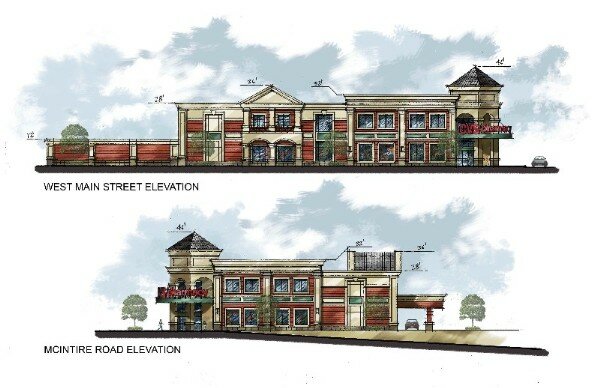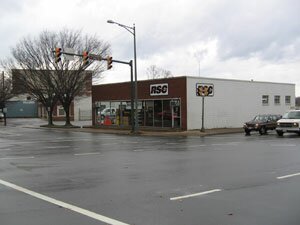ON ARCHITECTURE- 'Better enough?' Developer steamed by BAR ruling
On November 28, the Charlottesville Board of Architectural Review voted to reject a proposed design for a two-story CVS pharmacy on the site of RSC Equipment Rental on West Main Street, a project that has had the developer and BAR members at odds for months.
Since April, the BAR; the developer, Richmond-based Rebkee Company; and the architect, Baltimore-based John Mack of Carter & Burgess, have been going back and forth on discussions for the proposed $2 million, 13,000-square-foot pharmacy.
The tale bubbled into the public arena in a November 29 report in the Daily Progress.
"We didn't reject the first proposal; we simply made suggestions," says BAR vice-chair Syd Knight, denying the paper's suggestion that this was the BAR's third turn-down of the developer's plans. "The BAR encourages these kinds of preliminary discussions before a formal vote so the applicant can get an idea of BAR guidelines for downtown development."
Knight says BAR members were encouraged by the initial design, which included second-floor residences (a hallmark of mixed-used urban design), but they had concerns about whether the building was suited for the site.
"The design wasn't very conducive to foot traffic," says Knight. "And the parking in back required customers to walk all the way around to the front of the building– nearly 400 feet."
There were also concerns about some materials the developer wanted to use, including vinyl trim and columns, which Knight says are prohibited by historic guidelines. When the developers came back with a new design, according to Knight, they had taken it upon themselves to replace the proposed second-story residences with a partly faux second floor with storage space, offices, and false windows.
"Yes, they met the letter of the law, but not the intent," says Knight, pointing out that the zoning in that district requires at least two-stories. Two real stories.
"They argued, 'Whatever we build will be better than what's there,' Knight relates. "Yes, but it it going to be better enough? Wouldn't it be better for the City to wait and find a project that really suits the site?"
The intent of the guidelines, set out in the City's new zoning rules, is to encourage mixed-use, urban lifestyle-friendly buildings with shops and residences. But that appears to be something the developer wasn't willing to do.
According to the developer, Rob Hargett of the Rebkee Company, both the mixed-use plan and an alternate plan for office space on the second floor were abandoned because they weren't economically feasible.
"The BAR down there doesn't understand economics," says Hargett, who admits he has grown impatient with the BAR's insistence on following their guidelines. "Economically, only a single-use building would work on that site."
And so at the November 28 vote– which Hargett says he "forced" because he wanted to know if the BAR really wanted a CVS there– that's what he presented: a big, single-use CVS pharmacy.
"It was like trying to fit a square peg into a round hole," says Knight. "All the things about the building were not suited to the site."
The issue appears to have created a clash of sensibilities. Hargett accuses the BAR of trying to be zoning officials, of trying to "shape the building the way they wanted it," while the BAR accuses Hargett and company of making no attempt to understand the City's desire for mixed-use development.
As BAR member Lynne Heetderks told the DP after the November 28 vote, "I don't know when we've had an applicant who's been less responsive to the guidelines."
"It's zoned for what we want to do," Hargett insists. "The owner is allowed to have a 13,000-square-foot box on that site. They wanted three or four shops, and they wanted it designed their way."
Indeed, not having a 13,000-square-foot box on the site was exactly the BAR's point.
"It's a difficult site to build on," says Knight, "a wonderful site. But it will take a building specifically designed for it, not some off-the-rack design. It has to be a tailored suit."
Apparently, Hargett and company aren't the kind of developers who wear tailored suits.
"The BAR must be pretty powerful down there," says Hargett, clearly annoyed with the way the board is controlling the process.
When asked his next move– re-submit designs to the BAR, appeal the decision to City Council, or find a new site– Hargett says he hasn't decided.
"I think I'm going to take a week to get over my anger," he says, "before I start reflecting on what to do next."

On November 28, the BAR rejected this design for a new CVS pharmacy at the site of the RSC Rental Equipment building on West Main.
DRAWINGS COURTESY CARTER & BURGESS, INC.

Developers say their plan for the CVS pharmacy on the RSC building site is "better than what's there now." Yes, says one BAR member, but is it going to be "better enough"?
PHOTO BY DAVE MCNAIR
2 comments
Looking to bring business into an area to help promote economic development? Don't go to Charlottesville!
There's clearly a disconnect here: "'The design wasn't very conducive to foot traffic,' says Knight. 'And the parking in back required customers to walk all the way around to the front of the building-- nearly 400 feet.'"
Parking in back is almost universally considered to be _more_ conducive to foot traffic as opposed to parking in front which is considered to favor motorist and degrade the pedestrian environment. There may be a fine point that I'm missing here such as the distance being particularly excessive or there being a rear entrance that encouraged motorist to go straight in the back instead of walking around front. It's usually developer or the store operator that object to driving customers having to walk some distance from their cars. People arriving on foot are totally unaffected by distance to the parking lot except when it's too close.